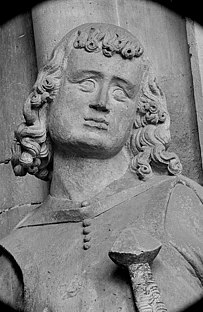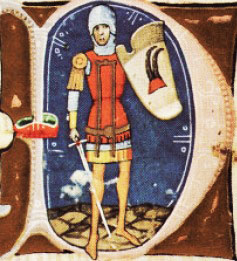William | |
|---|---|
| Margrave of Meissen | |
| Died | 1062 Hungary |
| Noble family | Counts of Weimar-Orlamünde |
| Father | William III, Count of Weimar |
| Mother | Oda of Lusatia |
William IV, Count of Weimar (died 1062) was Margrave of Meissen from 1046 until his death.
He was the eldest son of Count William III of Weimar from his second marriage with Oda, a daughter of Margrave Thietmar of the Saxon Eastern March. He became count of Weimar and Orlamünde in Thuringia upon the death of his father in 1039. William was appointed count palatine of Saxony in 1042.
When in 1046 Margrave Eckard II of Meissen died and willed his margraviate to Emperor Henry III, the emperor promptly granted it to William, who, through the second marriage of his mother Oda, also received the Thuringian estates of his stepfather Margrave Dedi II of Lusatia. Thereby, he united the territory held by late Margrave Eckard II of Meissen under his rule.
William remained a loyal supporter of the ruling Salian dynasty and, upon the death of the emperor in 1056, backed the regency of his widow Empress Agnes of Poitou. He was highly in favour with the empress, who gave him command alongside Bishop Eberhard of Naumburg, of the army in the 1060 campaign in support of King Andrew I of Hungary against his brother Béla I. According to the chronicler Lambert of Hersfeld, instead of waiting for an assisting Bohemian contingent under Duke Spytihněv II, they immediately attacked Béla's forces and the German army was soon in retreat. While King Andrew was deadly wounded, William and Bishop Eberhard were captured at the Battle of the Theben Pass near Moson (Wieselburg). However, Béla's son Géza, impressed by William's courage, induced his father to not only release him, but give him his daughter Sophia in marriage.
Meanwhile, William had returned to Germany. When in 1062 he again proceeded to Hungary to marry Sophia, however, he fell ill and died on his journey. Sophia married his nephew Margrave Ulric I of Carniola instead. The Meissen margraviate passed to William's younger brother Otto I.
The Peace of Bautzen was a treaty concluded on 30 January 1018, between Holy Roman Emperor Henry II and Bolesław I of Poland which ended a series of Polish-German wars over the control of Lusatia and Upper Lusatia as well as Bohemia, Moravia and Slovakia.

The Margravate of Meissen was a medieval principality in the area of the modern German state of Saxony. It originally was a frontier march of the Holy Roman Empire, created out of the vast Marca Geronis in 965. Under the rule of the Wettin dynasty, the margravate finally merged with the former Duchy of Saxe-Wittenberg into the Saxon Electorate by 1423.

Eckard II was Margrave of Lusatia from 1034 and Margrave of Meissen from 1038 until his death. He was the last of his dynasty, with his death the line of Ekkeharding margraves descending from Eckard I of Meissen became extinct.
The Bishopric of Merseburg was an episcopal see on the eastern border of the medieval Duchy of Saxony with its centre in Merseburg, where Merseburg Cathedral was constructed. The see was founded in 967 by Emperor Otto I at the same time in the same manner as those of Meissen and Zeitz, all suffragan dioceses of the Archbishopric of Magdeburg as part of a plan to bind the adjacent Slavic ("Wendish") lands in the Saxon Eastern March beyond the Saale River more closely to the Holy Roman Empire.
Ulric I, also Odalric or Udalrich, Count of Weimar-Orlamünde, was margrave of Carniola from 1045 and of Istria from 1060 to his death.
Poppo II, Count of Weimar-Orlamünde, was margrave of Carniola from 1070 and of Istria from 1096 to his death.

Eckard I was Margrave of Meissen from 985 until his death. He was the first margrave of the Ekkehardinger family that ruled over Meissen until the extinction of the line in 1046.

Herman I was Margrave of Meissen from 1009 until his death.
Dedi was the Margrave of the Saxon Ostmark from 1046 and a claimant for the title of Margrave of Meissen from 1069. He was the second son of Dietrich II of Wettin and Matilda, daughter of Eckard I of Meissen.
Otto I was the Margrave of Meissen from 1062 until his death in 1067, and the second Margrave of the family of the counts of Weimar and Orlamünde. He was a younger son of William III of Weimar and Oda, daughter of Thietmar, Margrave of the Saxon Ostmark. He inherited Orlamünde from his father in 1039 and Weimar from his brother William in 1062. He was appointed by the Emperor Henry IV to succeed William in Meissen as well. He became Advocate of the Cathedral of Merseburg in 1066.
Theodoric II was Margrave of Lusatia from 1032 to 1034, the first of the Wettin dynasty.
Oda of Meissen, also named Ode, Old High German form for Uta or Ute, was a Saxon countess member of the Ekkehardiner dynasty. She married Piast Duke Bolesław I the Brave as his fourth and last wife.
The German–Polish War consisted of a series of struggles from 1002 to 1018 between the Ottonian king Henry II of Germany and the Polish Piast ruler Bolesław I the Brave. The locus of conflict was the control of Lusatia, Upper Lusatia, as well as Bohemia, Moravia and Slovakia. The fighting ended with the Peace of Bautzen in 1018, which left Lusatia and Upper Lusatia as a fief of Poland, and Bohemia became a duchy in the Holy Roman Empire.
Sophia of Hungary, a member of the royal Árpád dynasty, was a Margravine of Istria and Carniola from about 1062 until 1070, by her first marriage with Margrave Ulric I, as well as Duchess of Saxony from 1072 until her death, by her second marriage with Duke Magnus Billung.

Berthold II of Andechs, a member of the House of Andechs, was a German nobleman. He was a ruling count of Dießen and Andechs in the Duchy of Bavaria, of Plassenburg and Kulmbach in Franconia, as well as bailiff of Benediktbeuern Abbey.
William III of Weimar was count of Weimar from 1003 and of the Eichsfeld from 1022.

Hahold (I) from the kindred Hahót, also known as Hahold the Great, was a German mercenary knight possibly from Thuringia who settled down in the Kingdom of Hungary. Promoting to the Hungarian nobility, he became the first member of the gens Hahót, thus he was also the forefather of the late medieval powerful Bánfi de Alsólendva family.
Gertrude of Northeim, was the daughter of Henry, Margrave of Frisia. Gertrude was heiress of Bentheim and Rheineck. She married first Siegfried I of Weimar-Orlamünde and then Otto I, Count of Salm.